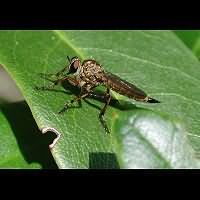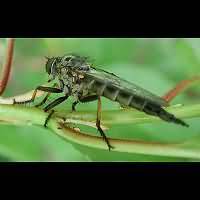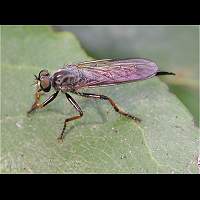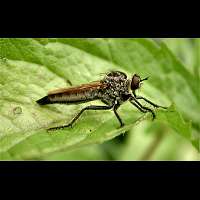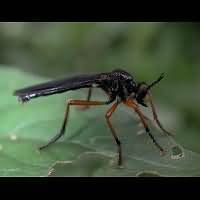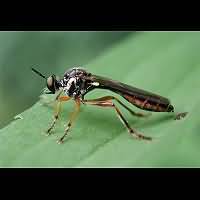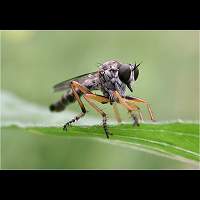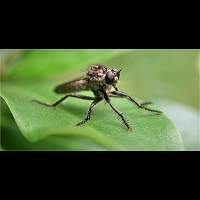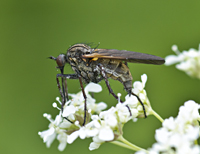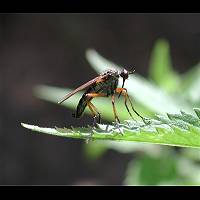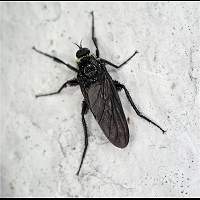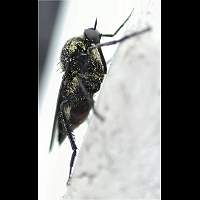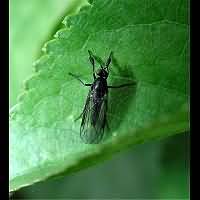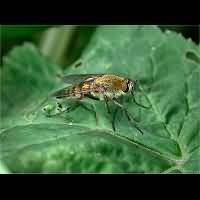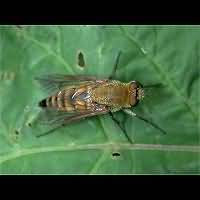[All pictures of garden wildlife on this page are thumbnails. Click on any thumbnail for a large format to be displayed.]
Robber Flies and alies (Several families)
Content: 1 Robber Flies, 2 Empididae, 3 Stilletto Flies.
![]()
Robber-flies, also known as Assassin Flies, are rather unattractive, hairy flies that hunt other insects, especially flies and mosquitoes. They are excellent flyers. They have a rather short, pricky snout, which they use to attack their prey and suck them dry. They are not easy to identify, for their are many species that do look rather similar. Just try to tell apart the species below. Thanks to the Dutch expert Han Endt we now know however that to your left is the Common Awl Robberfly. It is the most common Robber Fly in our garden. To the right with the greenish eyes Neoitamus cyanurus, another frequent visitor in our garden. Most individuals have a favourite spot to which they return after a kill. Robber flies may attack preys that are as big as they are themselves. They catch their prey in flight.
To the left: the Brown Heath Robberfly (Machimus cingulatus) is all over our garden. To the right: Common Awl Robberfly (Neoitamus cyanurus).
Below to the left Paritamus geniculatus, a less striking species. Is known to be rather rare, but that might be due to the fact it leads a very inconspicuous life. The species is only found on light sandy soils. Can be found in both Europe and the Near and Middle East, but it appears not to be numerous anywhere. Below to the right yet another, but rather similar species. The areal of this species is enormous. It lives not only in Europe and Turkey, but in Nortern Asia and Japan as well. On the British Isles though it is a very rare and endangered species. Well, my British friends: you can come to my garden and collect a few anytime. Robber Flies are not very afraid of people and therefor often easily photographed. Eutolmus rufibarbis usually attacks big prey: frequently even bigger than they are themselves, like Damsel Flies. Apparently Dragon Flies are a little too fast for him.
To the left the very uncommon Paritamus geniculatus. To the right the much more common Eutolmus rufibarbis.
Ruud van der Weele identified the species you see below to the left, Han Endt the one to the right. These species differ a bit from the other robber flies at this page: the wings are dark, the body is shorter than the wings en the legs are colourful. In this way it looks rather like a hover fly or a house fly. But just look at the needle shaped snout: This is a robber fly indeed. This species is very common in gardens in Western Europe. Of the robber fly to the right we managed to take only one good picture. If you don't look carefully, you might think it is a wasp and not a fly. There are several Dioctria species looking like that. The one below has the unique combination of a wasp like figure and yellowish legs.
To the left : this robber fly Dioctria oelandica is less frightening. To the right: a wasp like robber fly, called Dioctria hyalipennis.
Below to the left a light greyish robberfly. It has remarkable light legs. Not a very common species though, found in Southern England and Southern Wales only. More about this species by the time we make a separate information page about it. In the future we will also inform you about the robberfly below to the right: Philonicus albiceps
To the left: Neomochtherus pallipes is a robberfly with strikingly light legs. Philonicus albiceps to the right is much darker.
Empididae, also known as Balloon Flies, Empids or Dagger Flies, look very much like Robber Flies, but they are usually slightly more slender. They are hunters as well, capable of capturing remarkably big prey. The bigger species can be easily distinguished from Robber Flies as they have a long, dagger-like snout. The males often dance in small groups, each holding a prey. Should a female pass by, the males offer her their prey. She chooses the best looking prey and the couple disappears in the bushes. While copulating the female Empid sucks dry the prey offered by the male. The Dance Flies below apparently has no common name in English. The fly below to the left is one of the biggest and can be seen easily. The species below to the right actually is more common, but behaves in a less striking way. The difference bewteen the two is best seen by looking at the legs: Empis tesselata has black thighs and the remaining part of the legs are reddish brown. Empis opaca has orange reddish legs, including the thighs.
Both Empis tessellata to the left and Empis opaca to the right have impressive snouts, but they are unable to hurt people.
The fly below is known as the Black Dance Fly in Dutch. And indeed, this species is all black. It can be identified easily by looking at the rough hairs on the legs. In Holland it is an uncommon species usually only found near the big rivers. In Belgium it is rare. We could not found much references to this species in Britain on the internet, so it is quite psossible this is not a British species at all. But we are not absolutely sure about this. More about this species in the future.
Female of Empis ciliata has hairy legs.
Not very like its brothers above is this Empid below. It is shiny black, only 6mm long and has a very short snout. It belongs to the genus Hilara, of which some 60 species may be found in Britain. And it is a hell of a job telling the species apart. We have good reasons to believe this is Hilara maura, but we can not be absolutely certain. Of all Hilara species only the males have these swolen front legs. Actually these are silk producing glands. The male produces a thin silken wire and wraps his wedding gift in the silk before seducing a female. Hilara maura is especially seen on or near water. The small fly attacks whatever he thinks is edible, including pond-skaters! These are far too big for him, but attacking them, he will. This is one of the most common Hilara species in Britain.
No long snout, but curiously swollen front legs: a male Hilara, and most likely a male Hilara maura.
3 Stilletto Flies (Therevidae)
This family of long bodied and very hairy flies has not been studied very well. At this moment some 3,000 species are know to be around world wide, but probably there are many more. The majority is rather small. The adults often are difficult to find, because they don't show up on flowers like for instance the hover flies do. The adults hunt in a Robber Fly way, the larvae, looking rather like worms, live among dead leaves. They eat evrything from rotting plants to other insects and worms. Only a very few species regularly turn up in gardens. Most of these belong to the Thereva genus of beautiful velvet flies. The species below is one of these: Thereva nobilitata, a beautiful golden Stilletto Fly. We only know that it does live in the UK as well as in the Benelux, but we do not know anything about areas and numbers. The identification has been made by Andre van Eck and Kevin Holston (thanks to Martin Hauser).
This Stilletto Fly is known as Thereva nobilitata.

© Copyright 1998-2024 gardensafari.net (Hania Berdys)

 English / engels
English / engels  Dutch / nederlands
Dutch / nederlands